


Helping make tasks more efficient, digital technology is expanding in the workplace, and it’s all about the employee experience.
It’s not just expanding in the workplace either. A person armed with a smartphone can now order anything from Amazon for next day delivery, do all their banking, coordinate short-distance transportation and get a meal delivered within minutes, all from wherever they are.
The businesses behind these services have been designed to eliminate all frustrations and complexities, leaving a streamlined experience that people will share about and come back to repeatedly. Securing repeat customers, free word-of-mouth marketing, and new competitive opportunities are highly desirable outcomes for any organization. The discipline of Customer Experience (CX) has proven incredibly valuable.
Science writer Arthur C. Clarke’s, third law stated that “any sufficiently advanced technology is indistinguishable from magic.” Armed with these capabilities at the touch of a smartphone screen, we feel increasingly like magicians waving all-powerful wands.
But what about employees at work?
When the simplicity of what we experience as a consumer is contrasted with the inefficient systems at work, it’s no wonder that employees get frustrated and annoyed with enterprise tech. The beneficial outcomes of great CX are replaced by undesirable outcomes, such as poor employee engagement, low employee retention, and reduced customer satisfaction. Here’s three outcome chains that no business wants to intentionally pursue or create due to the enterprise tech on offer:
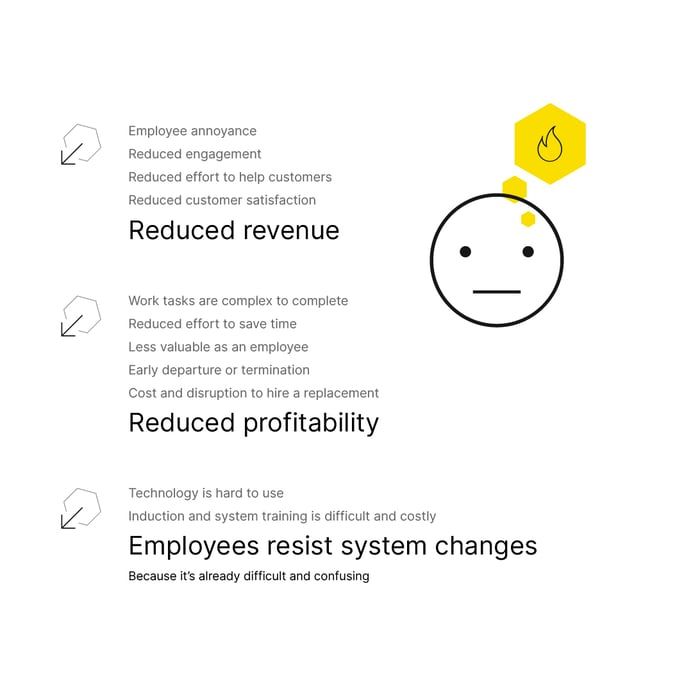
With the majority of the tasks that employees perform are coordinated and delivered via technology, the way technology works – or doesn’t – plays an ever-increasing impact on employee experience.
The discipline of Employee Experience (EX) is CX adapted for employees and is divided into three elements: work culture, physical environment and technology. An organization can develop a great work culture and provide a fabulous physical environment to work from, but the lack of appropriate enabling technology cripples the efforts, as shown in Figure 1.
Figure 1. Missing Elements Table of EX
| Work Culture | Physical Environment | Technology | Pattern or Result |
| Yes | Poor, insufficient | Poor, insufficient or missing | Grand ideas; no way of putting them into practice |
| Yes | Yes | Poor, insufficient or missing | Frustration at turning ideas into action due to inefficient processes and delivery capability |
| No unifying thread or theme; lack of clarity on what’s important | Yes | Poor, insufficient or missing | A pretty place with no purpose |
Technology is an essential component of the employee experience. Poor, insufficient or missing technology capabilities hinder the ability for employees to do their best work.
Power the pursuit of better employee experience and reimagine what’s possible at the enterprise-level by embracing an extensible technology. Great EX is about much more than the integration of disparate and disjointed apps through an old-school portal approach. It requires a deeper reimagining of how people and processes interact.
Great EX delivers benefits across five areas.
Pursuing satisfaction alone is a low standard in any avenue of life. While it’s essential to have needs met, “satisfaction” isn’t a high performance standard. Creating “moments of delight” for employees as they are using enterprise tech is a much higher standard to pursue.
Employees should be able to use the technology tools needed to do their work and leave with the sense of having interacted with something almost magical. This could be due to the ease of finding the right form (“it was just there”), requesting leave and having it approved instantaneously (and hence not being left with dangling vacation plans while the rusty gears of inefficient processes struggled to turn), or having the ability to execute a multivariable analysis to answer a complex question from a customer – simply and with immediacy.
Mergers and acquisitions, internal reorganizations, and silo-based approaches to developing organizational processes have resulted in complexity multiplied. Employees have to navigate through multiple systems that look different and behave poorly, copy-and-paste results from one system into another, or enter the same details into multiple screens to complete tasks that are conceptually simpler than the implementation suggests.
Taking an employee experience approach to technology is about systematically redesigning processes to just work––removing the accumulation of years of annoying quirks, and engineering out the mundane, repetitive, non-value-added tasks. A common example is onboarding a new employee, which often requires a manager to separately enter the new employee’s details into multiple systems in order to set up their employee profile, add payroll information, request a laptop and phone from IT, request office space from facilities, gain access permissions for the building, and request onboarding training. Taking an EX approach would streamline these separate processes into a single, unified, coordinated, enterprise-wide process. Any manager would find that delightful.
Reimagining how enterprise tech works to create streamlined processes that work and deliver frequent moments of delight to employees transforms the negative outcome chains above into the types of outcomes that all businesses claim they want:
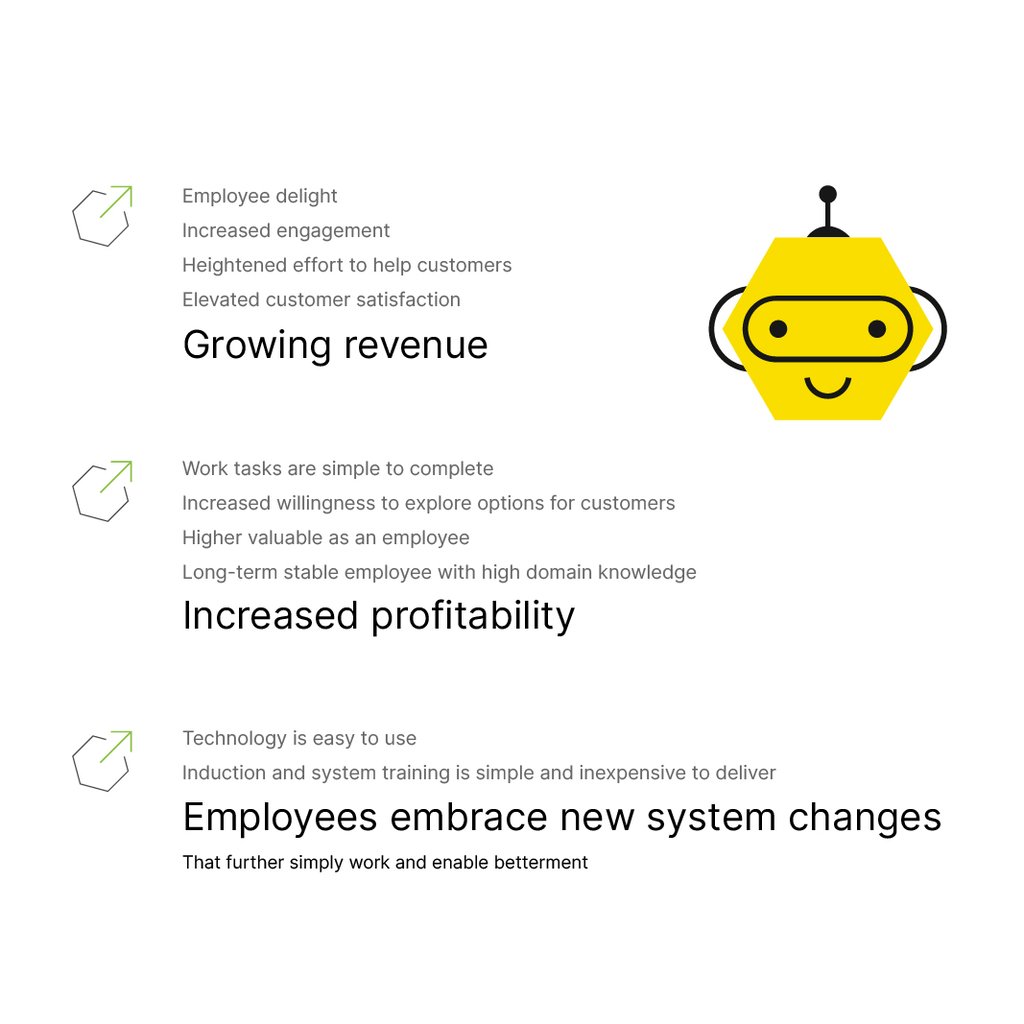
As you can see, the beneficial outcomes of great CX are also experienced in EX: high employee engagement, enduring employee retention, increased customer satisfaction and loyalty, and improved financial performance, among others.
In its research on employee preferences for digital and non-digital tools at work, PwC found that employees prefer digital tools for a range of HR scenarios (see Figure 2).
Figure 2. Preference for Digital Interactions
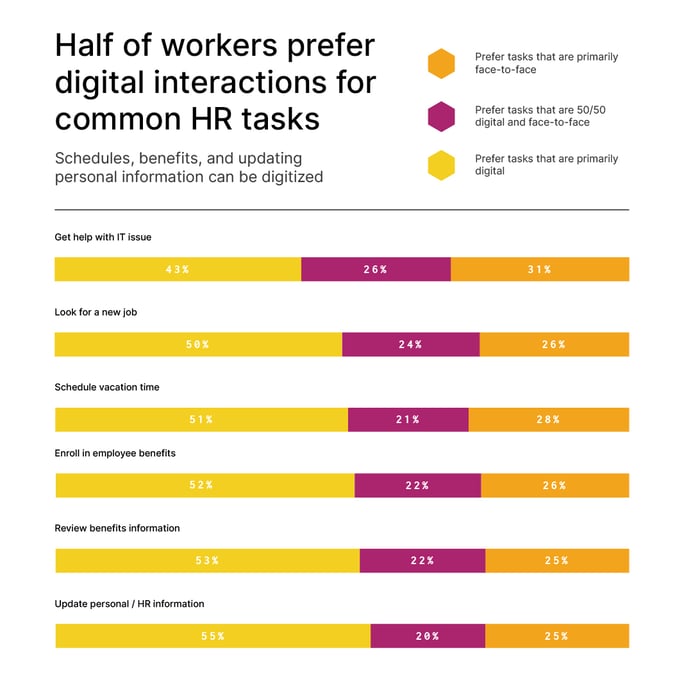
When I look at the above list, what I conclude is that employees prefer digital interactions for scenarios that fall into the Obvious quadrant of the Cynefin framework for decision-making (see Figure 3). If we adapt the framework for tasks employees need to complete, Obvious tasks can be approached from the perspective of best practice. Likewise, for all of the above tasks in the PwC list, a best practice approach can be engineered.
Figure 3. Cynefin Framework
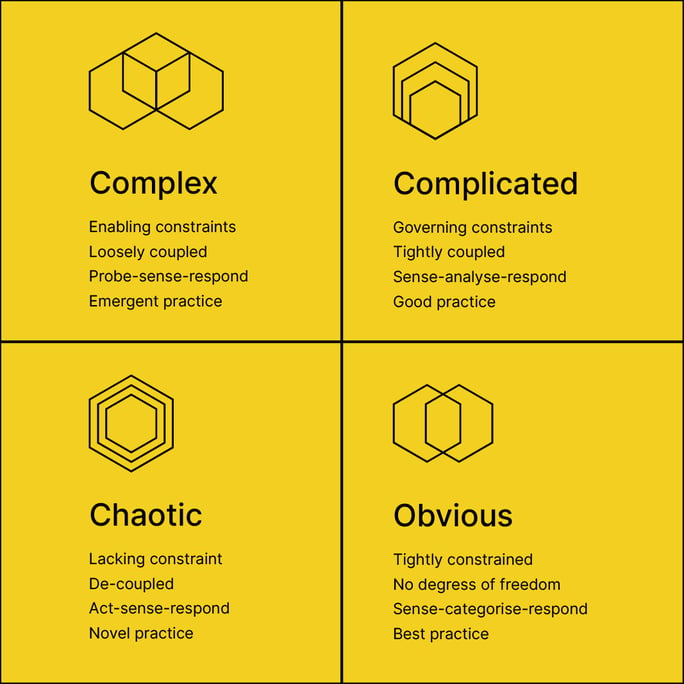
Minimizing the effort required by employees to complete tasks that have an Obvious answer or approach increases the time available for investing in tasks that fall into the other three quadrants. For many employees, this is where their passion, drive and ambition comes into play and creates high engagement. For example, having a streamlined way to enroll in employee benefits is a good thing to have, but mainly because it eliminates the expenditure of time, energy and effort that should be invested into the non-Obvious quadrant tasks that employees have been hired to deliver.
The frequent desire by today’s customers for more tech-enabled and app-delivered experiences is a result of heightened EX maturity. Simplifying the internal processes, interactions and systems across the enterprise lays the foundation for process automation enabling direct interaction by customers.
Activities that were previously impossible for customers to carry out, or required interacting with employees who only entered details into complex internal systems, can be customer-facing. Examples include online help desks, self-help customer communities with secure access to integrated knowledge bases, and order and fulfilment updates.
Great EX should be evident in the places where employees get their work done. For organizations with a digital workplace, it’s the perfect focal place to create moments of delight, design streamlined processes, and deliver tools that work for the right scenarios, etc. Connecting people, uncovering insightful data, enabling collaboration between people and across teams, and providing rich communication experiences are all possible with digital workplaces.
The growing availability of high-quality, delightful experiences for people in their non-work lives has given many employees a sense of how they’d like technology at work to work. Too few organizations, however, pay attention to their needs when introducing new technology. In fact, the PwC study above found that only about 50% of employees felt their needs were taken into consideration when new technology was introduced.
When introducing or implementing new technology, it’s important to have a strategy in place in order to ensure adoption, gauge user experience and keep employees engaged.
Employee experience technology is crucial for an efficient workplace. Combine the right technology platform with the willingness to engage employees to create new ways of working.
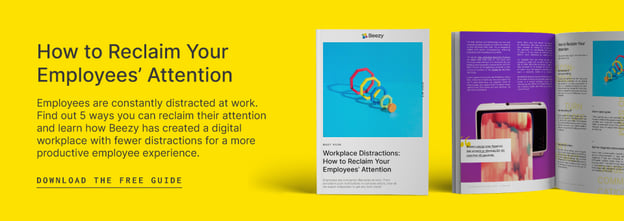
These Stories on employee experience

No Comments Yet
Let us know what you think